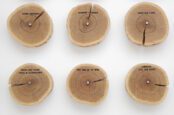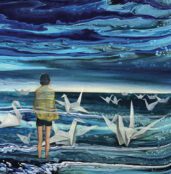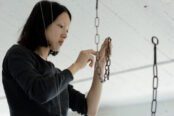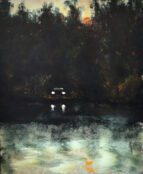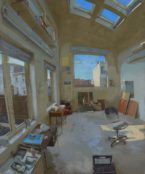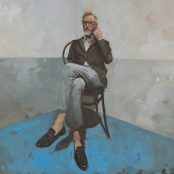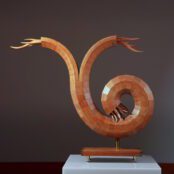Erasure is a futile act. No matter how hard a dominating force tries to remove a deviant stain, marks, gestures, presences of being linger. Even if they lie non-visibly, these residues are allusive, catalytic, evidencing what has come before as well as pointing to how the current composition of a thing could be different. The Goodwood Art Foundation’s winter exhibition, ERASURE (22 November 2025 to 12 April 2026), appears to embrace this spirit. Across the Foundation’s two galleries, Laís Amaral, Dana Awartani and Solange Pessoa confront devastating acts of cultural and environmental erasure, demonstrating how cultures persist as sites for revolutionary reassembly.
Pessoa is most known for her sculptural artworks and expansive installations made using organic materials. Drawing upon archaeological, prehistoric and craft traditions, her work gives a physical form to the dependencies of human life; how human existence is intertwined with the natural world. Recalling the form of a zen rock garden, in ERASURE sculptures from Pessoa’s ongoing pedra-sabão (soapstone) (2014–) series are dispersed throughout the Foundation’s Main Gallery and the immediate space outside of this, creating a contemplative ground wrought in poetry. Indeed, appearing like runes or petroglyphs – stones which have symbols engraved in their surface, often with spiritual significance – each of the carvings in this constellation depicts characters in an ambiguous alphabet; a simplified language expressed in star and seedhead motifs. These letter-forms are not precise, with chisel traces accentuating the contours in each cream-through-blue-grey stone. With this in mind, Pessoa’s work draws a material link between the human hand and the natural world. It seems of note that the forms used in this series directly references the cultural and ecological landscape of Brazil’s Minas Gerais region, a region ravaged by mining (colonial and contemporary). In this way, Pessoa’s stony garden expresses how acts of extraction not only fragment the natural world but shatter whole sociocultural landscapes.

Resting alone in the Foundation’s Pigott Gallery, a modernist window-walled space, Awartani’s precarious installation, I Went Away and Forgot You. A While Ago I Remembered. I Remembered I’d Forgotten You, I Was Dreaming (2017), has a similar sentiment. Based between Jeddah (Saudi Arabia) and New York (USA), Awartani’s practice draws upon her mixed Palestinian, Syrian and Jordanian heritage; specifically craft traditions, such as sacred geometry, which transcend colonially imposed divisions of geography, religion and ethnicity. Carried into the contemporary, Awartani uses these traditions critically, to comment on the forced erasure of certain ways of being; forms of being that are different to a Western vision of ‘norm’. I Went Away and Forgot You… pairs a patterned floor piece, laboriously made using coloured sand, and a 22-minute video recording the artist as she brushes a version of this floor into a neat pile. In itself, the installation is soundless, a quality that makes work feel elegiac. Indeed, on the face of it, it is as if the geometric floor is gazing towards its inevitable end as a pile of mournful dust. Based upon the tile patterns once common in domestic Islamic homes, Awartani’s sandy floor doesn’t rest beneath this video as an expectant memorial bemoaning the destruction of Islamic culture; it lies as a quiet celebration of craftsmanship and a metaphor reflecting how, even through devastation, cultures persist, emerging critically in new creative forms. Read in this way, I Went Away and Forgot You… manifests culture as a porous entity, a thing greater than any colonial interpellation.

Like Awartani and Pessoa, Amaral draws upon cultural and craft practices that have historically been treated as lesser than Western fine art. A self-defined ‘artist-artisan’, Amaral has no formal arts education, her motley paintings emerge from a mix of sociocultural urgency and self-determination. Further, the cofounder of the Trovoa collective – a collective of racialised women based in Niterói, Brazil – for Amaral, the production of art is an innately political act, a way to give a voice to the bodies otherwise silenced by administrations of oppression – racialised, indigenous, and non-male bodies in particular. An extension to Amaral’s work as a social organiser, cultural and climate activist, compositions such as Entre domir e acordar (2021) exude something of this restive spirit through its raucous explosion of red and blue-tipped white lines.

The first time Amaral’s work has been exhibited in the UK, at Goodwood her mixed media paintings appear as the material and metaphorical fabric uniting the exhibition’s core themes. Often depicting what look like aerial views of a deranged landscape, Amaral creates her compositions through an iterative process of layering acrylics, oils, inks, and spray paints on canvas, then gouging into this fertile ground with objects associated with personal grooming – cuticle pushers, tweezers and combs. Hung in overseeing Pessoa’s soapstones, the process of production and the visual form of these deeply haptic paintings further testifies to the interdependency of human and ecological forms of life. Indeed, developed from her investigative work into ecological crimes and the cataclysmic sociocultural impact of climate finance in the Amazonian region, Amaral’s paintings read as harrowing maps which evidence of how international ecological policies are tearing apart indigenous sociocultural landscapes. As with Awartani’s work, these paintings are not a mournful vision of indigenous precarity. Formally, in cutting through dense layers of suit-black and grey pigment, Amaral’s sharp assemblies give voice to indigenous world-systems, instantiating how personhood is rooted in collective – social, cultural and ecological – sustainability.

As the United Nations Climate Change Conference in Brazil draws to a close (November 21 2025), each of the artworks in ERASURE manifest a spirit of resistance to the policy chat being had in those harrowed conference halls. Embracing forms of life that coloniality aims to expunge, the material stuff of Pessoa, Awartani and Amaral’s works speaks double, shattering the colonial composition of the present while demonstrating the revolutionary potential found in cultural persistence.
ERASURE with work by Laís Amaral, Solange Pessoa and Dana Awartani
22 November 2025 – 12 April 2026
Goodwood Art Foundation
Images courtesy of Goodwood Art Foundation
Travel supported by Goodwood Art Foundation

Toby Üpson, is a writer based in Glasgow. In 2025, his first collection of poems was published by La chaise jaune.



